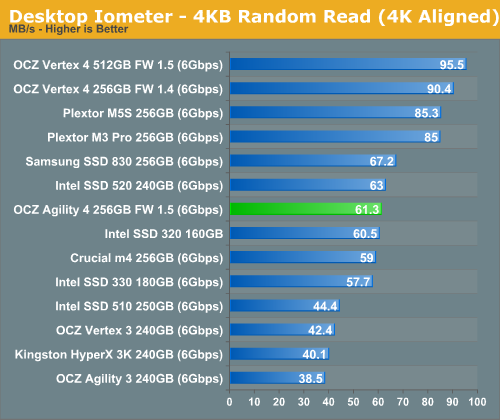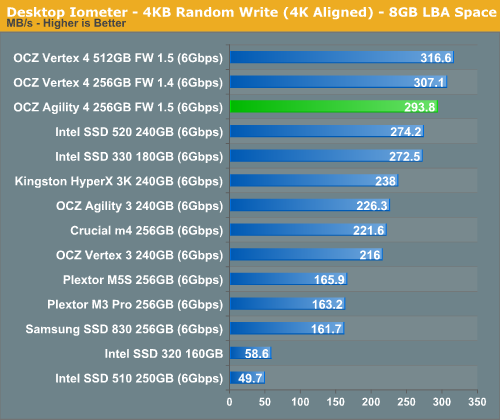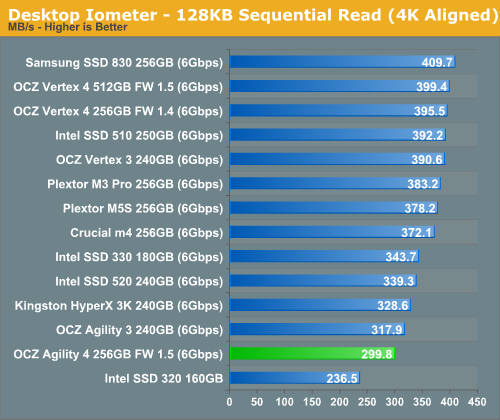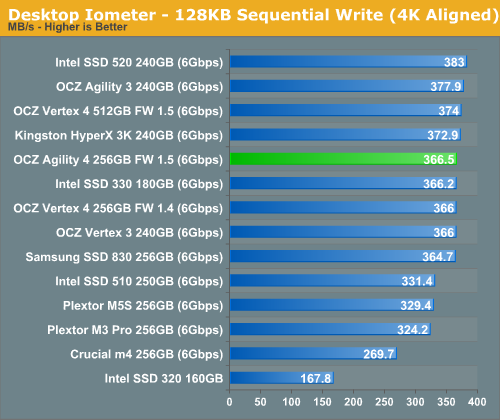OCZ Agility 4 (256GB) Review
by Kristian Vättö on September 1, 2012 1:00 PM ESTRandom Read/Write Speed
The four corners of SSD performance are as follows: random read, random write, sequential read and sequential write speed. Random accesses are generally small in size, while sequential accesses tend to be larger and thus we have the four Iometer tests we use in all of our reviews. Our first test writes 4KB in a completely random pattern over an 8GB space of the drive to simulate the sort of random access that you'd see on an OS drive (even this is more stressful than a normal desktop user would see).
We perform three concurrent IOs and run the test for 3 minutes. The results reported are in average MB/s over the entire time. We use both standard pseudo randomly generated data for each write as well as fully random data to show you both the maximum and minimum performance offered by SandForce based drives in these tests. The average performance of SF drives will likely be somewhere in between the two values for each drive you see in the graphs. For an understanding of why this matters, read our original SandForce article.

The performance difference between synchronous and asynchronous NAND is pretty clear here. At queue depth of 1, 4KB random reads are heavily dependent on the speed of NAND. Queue depth of 1 means that only one I/O request is sent at a time, which means the controller can only read from one NAND at a time (write combining helps work around this issue). Increasing queue depth allows the controller to read from multiple NAND dies at the same time, which leads to better performance especially when dealing with slower NAND (you can always hide latency with parallelism). Our 4KB random read test happens at queue depth of 3, which gives the Agility 4 some breathing room but it's still enough to show the difference between asynchronous and synchronous NAND.
Note that with bigger transfers, this is not as big issue because they are usually broken into smaller pieces and striped across multiple NAND dies, again allowing the controller to utilize multiple NAND dies simultaneously. Obviously, you need a fast controller and firmware to really notice the impact of slower NAND, which is exactly what the Everest 2 is.


Random write performance isn't impacted as much by the slower NAND, not even at queue depth of 1. When reading data from an SSD, the data has to be fetched from the actual NAND, which can create a bottleneck with slower NAND. Write IOs, on the other hand, can be cached to much faster DRAM before written to NAND. Today's SSDs have fairly big caches so the NAND will have plenty of time to catch up. Of course, ultimately you will hit a wall and the NAND becomes a bottleneck. After our 20 minute torture session (4KB random writes at queue depth of 32 and 100% LBA space ran on a full drive), the Agility 4 was writing at 19.1MB/s, while 256GB Vertex 4 was chugging along at 28.4MB/s.
Sequential Read/Write Speed
To measure sequential performance we ran a one minute long 128KB sequential test over the entire span of the drive at a queue depth of 1. The results reported are in average MB/s over the entire test length.

Sequential read performance is slower compared to Vertex 4 so we are definitely being limited by NAND here.

Sequential write speed is in fact on-par with Vertex 4. The bottleneck is obviously something else than NAND because quite a few drives are hitting the same speeds. We're likely running into the limits of how much parallelism you can extract from a low queue depth 128KB sequential transfer.










41 Comments
View All Comments
CaedenV - Tuesday, September 4, 2012 - link
The entire Agility/Vertex 2 line was pretty bad. The 3's had a rough start with several major firmware updates, but after that they have really upped their quality quite a lot. Not saying that they would hold a candle to the likes of Crucial, Intel, or Samsung, or that they should be trusted in a 'mission critical' role (because they shouldn't). But as budget drives for a home system, they are really not bad.I was burnt also with some of the early power supplies, which were absolutely trash. But after OCZ purchased PC Power and Cooling they really turned things around, and my most recent OCZ power supply has some of the most accurate voltages I have seen for anything near it's price range (and that is before rebate). Again, they are not for anything mission critical, but they are also not advertised for it, nor priced for it. The current ones at least work more than well enough for home use.
At any rate, they are a budget company, and as such they are hit-and-miss. Complaining that a budget oriented company like OCZ does not compare on quality to the likes of a high-end company like Samsung is like comparing a Nissan to a BMW. They both sell cars, but they are not remotely in the same market.
celestialgrave - Tuesday, September 4, 2012 - link
Did I miss it or was power not checked this time? Perhaps safe to assume very close to the Vertex 4 for power consumption?hasseb64 - Wednesday, September 5, 2012 - link
AnandTech, why are you given OCZ a FW variable in your tests?I thought that AnandTech was a serious hardware site?
Do not let OCZ or any other sloppy company get a 2nd chance with a “FW at consumer development strategy”.
Superneato - Wednesday, September 5, 2012 - link
I'm assuming the Agility 4 is the boot drive in this test. Exactly what method is used to TRIM the drive manually? I have the same question regarding how the drive was secure erased for this test.Kristian Vättö - Wednesday, September 5, 2012 - link
I just use Windows' Disk Management to format the drive, which will TRIM all user accessible LBAs.As for secure erase, I use Linux and its Terminal (basic hdparm commands).
Superneato - Wednesday, September 5, 2012 - link
You can format the boot drive from inside the booted OS? I must be missing something or do you have the test SSD installed as a secondary drive?Thanks for the fast reply.
Kristian Vättö - Thursday, September 6, 2012 - link
All SSDs are tested as secondary drives. Using it as a boot drive can create more variables (the OS may be reading/writing in the background, which would affect the results).poccsx - Thursday, September 6, 2012 - link
I still can't figure out who makes the fastest SSD, they all seem to have their strengths and weaknesses.albtocxhtrqm - Thursday, September 6, 2012 - link
nice review but when I look for a ssd i look for price and reliability and then speed. I don't see the reliability factor tested here.Why not a reliability index based on reviews on 20. 50. 100 main websites like amazon, newegg, tigerdirect etc..
For instance:
OCZ Agility 512GB newegg.ca, september 06, 2012, 38% 1 star
The more websites the more reliable this index would be.
Eryxx - Thursday, October 11, 2012 - link
I did it, I succumbed to my inner cheapness and saved a few $$ by buying an OCZ Petrol 128G ~7 months ago.Sure, it was faster than my WD Cav. Black 640GB, but from Day 1, the SSD gave me issues. I had to back it up weekly, do a secure erase using the OCZ Linux tools, then reimage the drive to keep it running correctly. If I let it go longer than a week without doing this, it would begin randomly locking up the system. Still, when it worked, it was much faster, so I suffered through.
One day, the Petrol simply could not be detected by the BIOS, like it was just gone. Couldn't do anything with it, even the Linux tools could no longer detect it, so RMAd back to OCZ.
Roughly 10 days after the Petrol failure, I received a brand-new Agility 4 128GB. Oh, joyous day, right? No.
Right out of the package, my BIOS cannot see this drive. I've tried every procedure recommended by OCZ and dozens of users on their forums, this thing will not show up in AHCI mode, period. It WILL appear in IDE mode, and even in AHCI it DOES show up in Win Explorer and Device Manager once you boot with another drive.
Yes, I've updated the BIOS, isolated the drive so it's connected all alone, new SATA cable, different ports, reflashed the SSD firmware, blah, blah, blah, this thing just won't detect in my system in AHCI. Will yet another drive fare any better? I highly doubt it, but I have little recourse but to try, or possibly wait for another firmware revision which might solve this.
If you check the OCZ forums, there are a lot of other posts with similar issues on the Vx4/Ag4 line, so I don't seem to be alone in my misery.
OCZ for your next SSD? Caveat emptor, my friend.